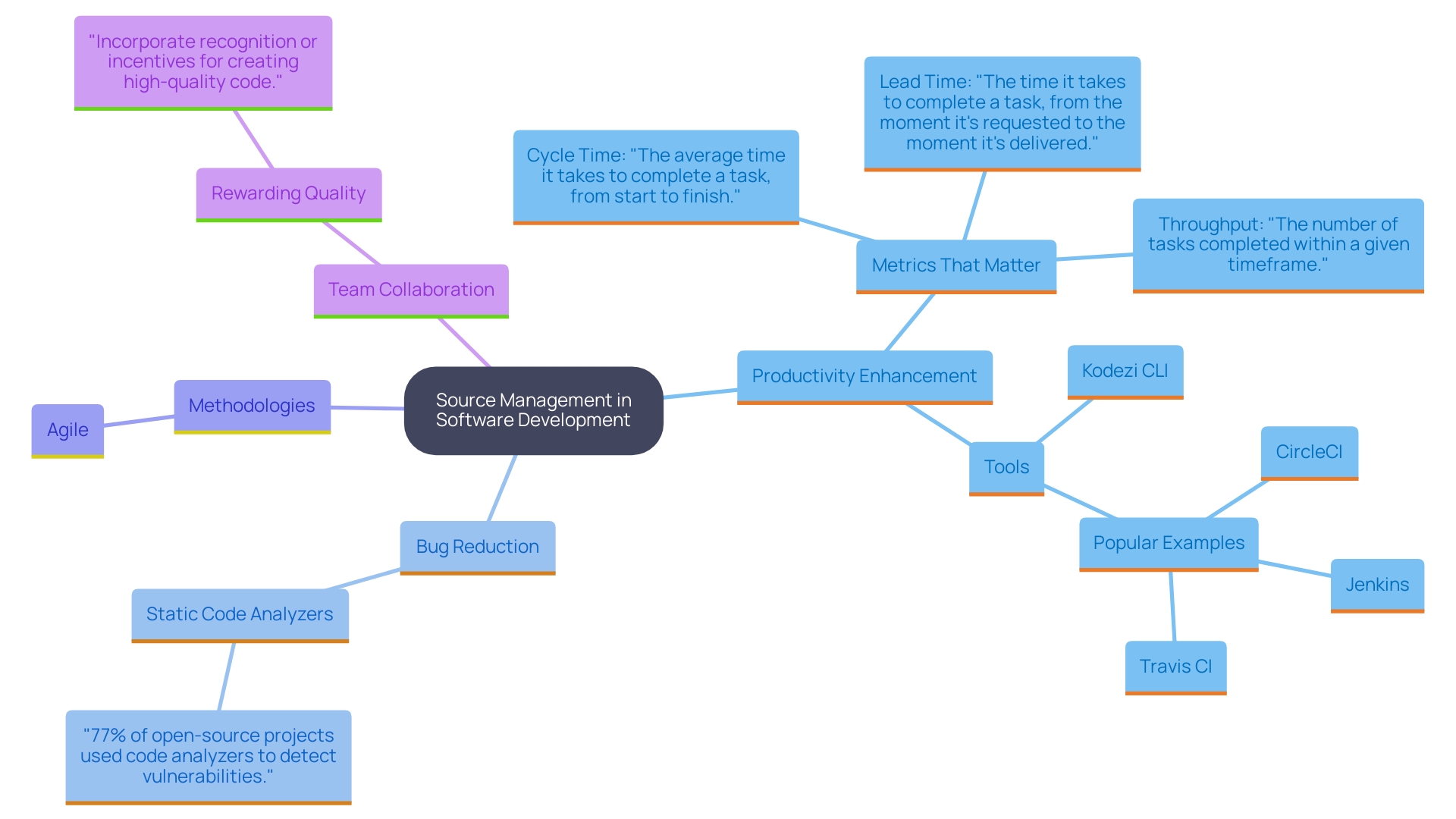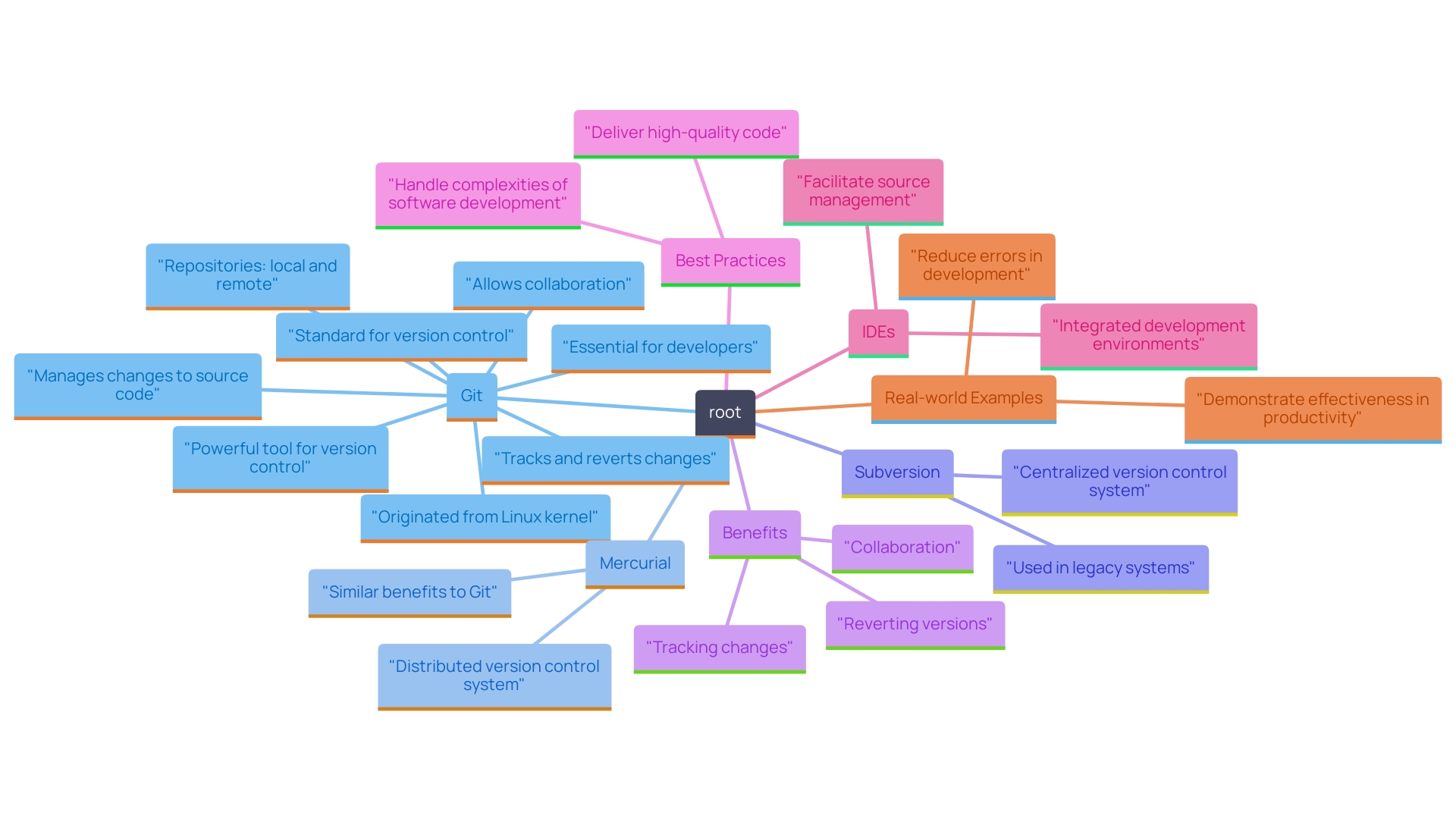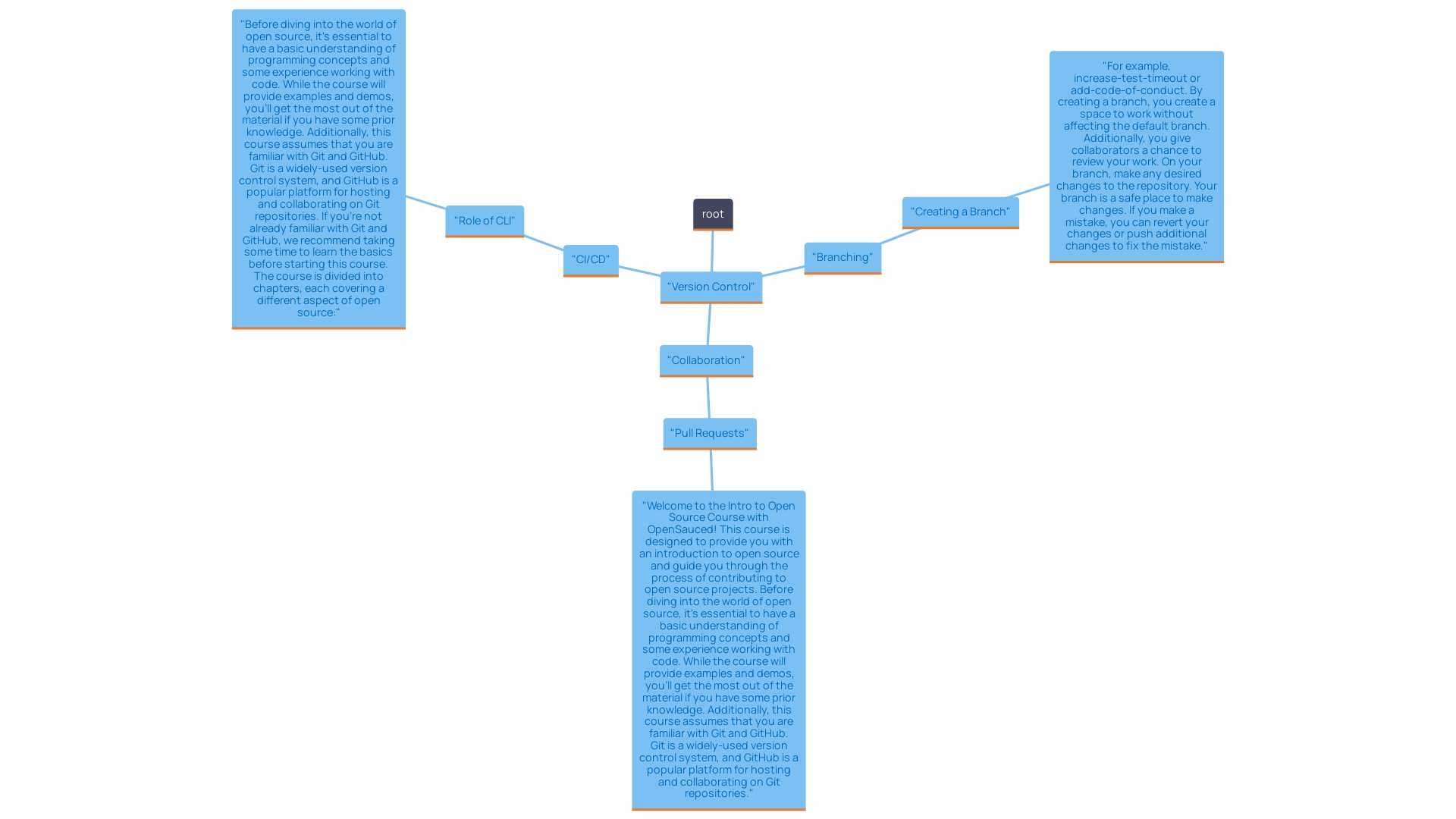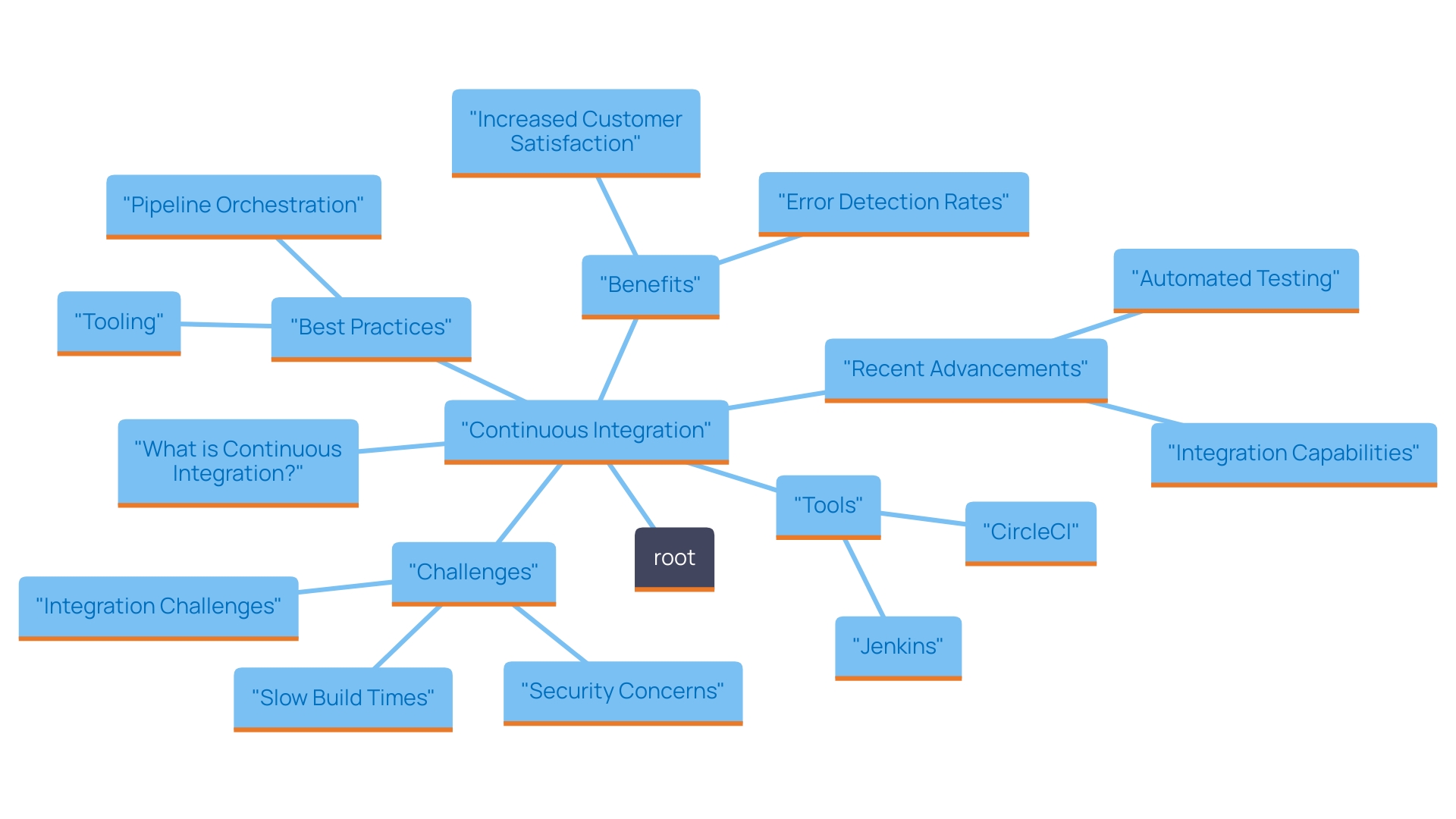Introduction
In the realm of software development, source code serves as the essential framework that dictates how applications function. As the industry evolves, understanding and managing this code effectively has become paramount for fostering collaboration and enhancing productivity. With the advent of innovative tools like Kodezi, teams can streamline their workflows, automate tedious tasks, and significantly improve code quality before it reaches production.
This article delves into the critical aspects of source code management, highlighting best practices, essential tools, and the transformative role of continuous integration. By embracing these strategies, development teams can not only boost their efficiency but also create superior software solutions that meet the demands of today's fast-paced digital landscape.
Understanding Source Code: Definition and Importance
Source text forms the backbone of software development, consisting of instructions in a programming language that dictate how software operates. This blueprint is essential for developers to create, modify, and maintain . Comprehending source material is crucial; it improves readability and maintainability, encouraging better collaboration among group members. Tools like Kodezi CLI enable B2B engineering teams to independently enhance software quality and rectify issues before they reach production, thus making source management significantly more efficient.
Research indicates that effective source management can enhance productivity by as much as 30% and decrease bugs by 25%, significantly improving overall software quality. For instance, Microsoft's integration of Test-Driven Development (TDD) into their processes involved writing failing unit tests before implementation, ensuring that each segment was thoroughly validated. As stated by a Microsoft engineer, 'Writing tests first offers clarity and encourages developers to think critically about their work, resulting in higher-quality outcomes.'
Moreover, adopting methodologies like Agile—such as Scrum or Kanban—ensures ongoing quality and adaptability. These frameworks emphasize the significance of regular communication and group composition, optimizing project outcomes customized to specific needs. The automated debugging capabilities of the platform further facilitate rapid issue resolution, performance optimization, and security compliance, reinforcing the critical role of source management. By streamlining development with Kodezi, groups not only produce superior software products but also enhance their overall efficiency and productivity.

Essential Tools and Best Practices for Effective Source Code Management
To effectively manage source code, leveraging version control systems (VCS) such as Git, Mercurial, or Subversion is crucial. These tools empower developers to meticulously track changes, collaborate seamlessly with team members, and revert to previous versions with ease when necessary. Integrating Kodezi Code into your workflow significantly enhances programming productivity, acting as a Swiss-Army knife for developers. Its automated debugging facilitates rapid issue resolution, swiftly addressing performance bottlenecks and security compliance concerns.
Adopting best practices in source management is essential for maintaining consistency and efficiency. Frequently making changes ensures a clear history of development evolution, while writing descriptive commit messages facilitates better understanding of modifications. Additionally, using branches for new features or experiments prevents disruptions in the main codebase.
Integrated development environments (IDEs) such as Visual Studio Code, JetBrains IntelliJ IDEA, and GitKraken, which support source control integration, can significantly enhance your workflow. These tools offer a unified interface for managing modifications, reducing the time spent on version control tasks and enhancing overall productivity. Kodezi’s AI-driven automated builds and testing capabilities further elevate software quality by catching bugs before they multiply, ensuring each release improves upon the last. Recent statistics indicate that approximately 72% of developers utilize IDEs with integrated version control, underscoring their importance in modern software development. As Facundo Farias aptly stated, 'While all mentioned tasks can be accomplished through the command line, using a dedicated Git client can boost our productivity as developers and offer better visibility during Git operations.' This highlights the value of utilizing advanced tools in conjunction with traditional methods.
Real-world examples highlight the significance of effective source management. Sourcecode, a company established in 1992, faced significant challenges in financial reporting due to reliance on Excel. Transitioning to , a robust version control system, streamlined their financial reporting, eliminated manual processes, and reduced potential errors. This transformation not only enhanced their current operations but also prepared them for rapid future acquisitions, demonstrating the profound impact of using advanced VCS tools, similar to the benefits provided by Kodezi in codebase management.

Core Concepts of Source Code Management and Version Control
Effective source management hinges on the principles of version control and branching. Version control meticulously tracks every alteration to the codebase, ensuring a clear history of changes and facilitating easier rollbacks when necessary. Branching empowers developers to work on new features independently, safeguarding the main codebase from potential disruptions and allowing for innovation without compromising stability.
A crucial element of collaboration is the use of pull requests, which allow team members to review, discuss, and refine changes before merging them into the primary branch. This process not only upholds quality but also reduces conflicts, promoting a collaborative atmosphere that is vital in today’s agile development landscape.
In 2023, we launched CLI, a powerful tool that enables professionals to seamlessly integrate it into their CI/CD pipelines and utilize its features locally. This integration significantly enhances efficiency by automating repetitive tasks, enabling developers to focus on producing high-quality software. For example, Kodezi CLI can automate reviews and ensure adherence to programming standards, thereby optimizing the process and decreasing the time to market.
As Dan Radigan aptly puts it, 'Agile has had a huge impact on me both professionally and personally as I've learned the best experiences are agile, both in code and in life.' His viewpoint highlights the agility and efficiency that strong version control and branching practices contribute to software creation.
For instance, Helix Core offers built-in best practices for version control branching, guiding developers through the intricacies of branching and merging. Such practices are essential in assisting groups to visualize changes and accelerate the creation and release pipelines. Additionally, with the increase of continuous integration (CI) practices, CI servers can automatically test new branches, ensuring that stability is upheld in the main programming line, thereby streamlining the entire creation process.
Statistics show that modern version control systems, like Perforce Streams, can support thousands of contributors branching simultaneously. This scalability not only enhances efficiency but also aligns with current trends in version control systems for 2024, where collaboration and speed are paramount. By understanding and implementing these core concepts, software teams can achieve higher productivity and deliver superior results.

The Role of Continuous Integration in Source Code Management
Continuous integration (CI) is an essential practice in modern software development, where automated testing and integration of changes into a shared repository are conducted seamlessly. Tools such as Jenkins, Travis CI, and CircleCI are set up to automatically run tests and build processes with every push of the source. This approach not only ensures early error detection—leading to a 25% increase in customer satisfaction scores—but also significantly enhances overall quality of the software.
Recent advancements in have further enhanced the capabilities of CI tools, allowing for more comprehensive test coverage and quicker feedback loops. For instance, Jenkins has become a cornerstone for many software projects due to its robust plugin ecosystem and ease of integration. Real-world examples illustrate how CI tools have led to more reliable deployments and proactive issue detection, with projects adopting CI practices reporting a substantial reduction in error rates—some studies show up to a 40% improvement in error detection rates, underscoring their effectiveness in maintaining a stable codebase.
Case studies on continuous integration underscore its transformative impact on source code management. By establishing reliable CI/CD pipelines and fostering a culture of continuous learning and collaboration, teams can streamline their deployment processes and ensure seamless integration of new features. Notably, the recent launch of the CLI in 2023 empowers professionals to seamlessly integrate it into their CI/CD pipelines, utilizing its powerful features locally to enhance efficiency and productivity.
The extension for Visual Studio Code further assists developers by offering seven unique features—including debugging, optimization, and conversion—designed for various programming languages. As we move into 2024, the landscape of continuous integration continues to evolve, with tools like Jenkins and Kodezi introducing innovative features that enhance their functionality and integration capabilities. The role of CI in source management is indispensable, making it a cornerstone of efficient and productive software development.

Navigating Challenges in Source Code Management
Handling source material poses numerous difficulties, especially in the realms of dependency management, compliance with licensing obligations, and encouraging group collaboration.
Dependency Management: Effectively handling dependencies is crucial, as it significantly impacts the stability and security of software projects. Establishing clear guidelines for dependency management is essential. Utilizing tools such as Dependabot or npm audit can help monitor and mitigate vulnerabilities, ensuring a more secure codebase. Additionally, Kodezi's AI-powered programming tool enhances this process by automatically correcting code, analyzing bugs, and improving productivity across multiple languages, making dependency management not only efficient but also more reliable.
Group Cooperation: Improving collaboration within the group is equally important. Encouraging open communication allows for regular updates and discussions about key learnings and future improvements. For instance, a developed a transit navigation app for the visually impaired, achieving a 90% user satisfaction rate by leveraging voice recognition and real-time GPS tracking. This success underscores the importance of clear communication and strategic planning in software development. Moreover, Kodezi assists groups by offering a generation feature that utilizes curated instructions and natural language. This capability allows both students and developers to generate high-quality software efficiently, fostering better collaboration and innovation within the group.
Investing in Training: Ultimately, investing in training on best practices for source management guarantees alignment and efficiency throughout the group. As Chevas Balloun, a specialist with more than 15 years of expertise in branding and engagement for firms like Microsoft, highlights, a knowledgeable group is better prepared to manage the intricacies of contemporary software creation. By utilizing Kodezi's features, groups not only enhance their debugging and code compilation processes but also gain valuable insights into the nature of bugs, empowering them to improve productivity and deliver high-quality software solutions. This holistic approach to training and tool integration positions teams for success in today's fast-paced development environment.

Conclusion
Effective source code management is crucial for developing high-quality software in today’s fast-paced digital landscape. By understanding the fundamental aspects of source code, including its definition and importance, teams can enhance collaboration and productivity. Tools like Kodezi play a transformative role by streamlining workflows, automating repetitive tasks, and ensuring code quality, ultimately leading to superior software solutions.
Implementing robust practices such as version control, branching, and continuous integration further amplifies these benefits. Utilizing version control systems allows teams to track changes meticulously and maintain a clear history, while continuous integration fosters a culture of early error detection and proactive issue resolution. Kodezi’s innovative features, such as automated code reviews and debugging, seamlessly integrate into these practices, reinforcing the efficiency of the development process.
However, challenges in source code management, including dependency management and team collaboration, cannot be overlooked. By investing in training and leveraging advanced tools like Kodezi, teams can navigate these complexities effectively, ensuring a cohesive approach to software development. This holistic strategy not only improves productivity but also positions teams to deliver exceptional software that meets the evolving demands of users.
In conclusion, embracing effective source code management practices, powered by tools like Kodezi, is essential for any development team seeking to enhance their efficiency and produce high-quality software. With the right strategies in place, teams can overcome challenges and achieve remarkable outcomes, paving the way for innovation and success in the software development arena.
Frequently Asked Questions
What is the importance of source code in software development?
Source code forms the backbone of software development, consisting of instructions in a programming language that dictate how software operates. It is essential for creating, modifying, and maintaining robust applications, improving readability and maintainability, and encouraging better collaboration among team members.
How can effective source management impact software quality?
Effective source management can enhance productivity by up to 30% and decrease bugs by 25%, significantly improving overall software quality. Techniques such as Test-Driven Development (TDD) ensure thorough validation of code segments, leading to higher-quality outcomes.
What role do version control systems (VCS) play in source code management?
Version control systems like Git, Mercurial, or Subversion allow developers to track changes, collaborate seamlessly, and revert to previous versions easily. They are crucial for maintaining a clear history of development and enhancing consistency and efficiency in source management.
What are some best practices for source management?
Best practices include frequently making changes to maintain a clear history, writing descriptive commit messages, and using branches for new features or experiments to prevent disruptions in the main codebase.
How do integrated development environments (IDEs) enhance source code management?
IDEs such as Visual Studio Code and JetBrains IntelliJ IDEA support source control integration, offering a unified interface for managing modifications. This reduces the time spent on version control tasks and enhances overall productivity.
What is the significance of continuous integration (CI) in software development?
Continuous integration involves automated testing and integration of changes into a shared repository, ensuring early error detection and significantly enhancing software quality. CI tools like Jenkins and CircleCI help maintain a stable codebase and streamline deployment processes.
What challenges are associated with handling source material?
Challenges include dependency management, compliance with licensing obligations, and fostering group collaboration. Establishing clear guidelines and utilizing tools can help mitigate these issues.
How can teams improve collaboration in software development?
Encouraging open communication and regular updates on key learnings and improvements can enhance collaboration. Tools like Kodezi also assist teams by offering features that generate high-quality software efficiently.
Why is investing in training important for source management?
Investing in training on best practices for source management ensures alignment and efficiency within the team. A knowledgeable team is better equipped to manage the complexities of modern software development, improving productivity and software quality.




